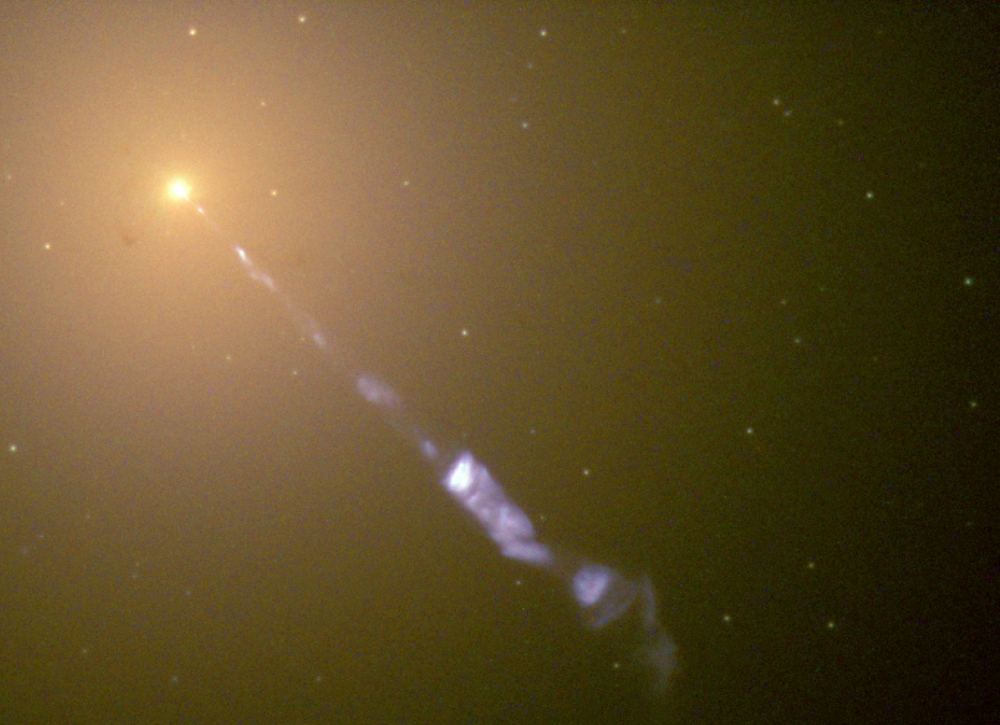Blazars occupy an intriguing spot in the cosmic zoo. They’re bright active galactic nuclei (AGN) that blast out cosmic rays, are bright in radio emission, and sport huge jets of material traveling in our direction at nearly the speed of light. For some blazars, their jets look curvy and snaky and astronomers have questions.
Does a blazar’s central black hole’s appetite affect the jets? Is there some internal activity in the accretion disk that causes the variability in brightness? Or, is something else at work here? According to Silke Britzen of the Max Planck Institute for Radio Astronomy in Germany, it might be more interesting than one black hole (or its accretion disk) doing its thing.
“We present evidence and discuss the possibility that it is in fact the precession of the jet source, either caused by a supermassive binary black hole at the footpoint of the jet or – less likely – by a warped accretion disk around a single black hole, that is responsible for the observed variability,” said Britzen from the Max Planck Institute for Radio Astronomy in Bonn, Germany.
The Galaxy with Two Black Holes
The idea of a precessing warped accretion disk around one supermassive black hole is interesting because that motion could affect the jets. It also plays a role in those periodic changes in brightness. That effect shows up in some other galaxies, too. But, what else could cause the precession? Britzen and the team investigated an object called OJ 287 to see if it could give some clues. It appears to have two black holes—essentially a black hole binary—at its core. Studies of this galaxy and 12 other AGNS led to the conclusion that jet curvature may provide a smoking gun clue to the existence of binary black holes in galaxy cores.
How would that work? It’s complex, but essentially, you have two black holes doing an orbital dance in the center of the galaxy. One black hole is emitting the jet and the other one’s gravitational influence affects the appearance and behavior of the jet. According to Michal Zajacek, who is a co-author of the study with Britzen, it helps explain the jet’s appearance. “Physics of accretion disks and jets is rather complex but their bulk kinematics can be compared to simple gyroscopes,” he said. “If you exert an external torque on an accretion disk, for instance by an orbiting secondary black hole, it will precess and nutate, and along with it the jet as well, similar to the Earth’s rotation axis that is affected by the Moon and the Sun.”

Searching for the Black Hole Binaries
If this is the case for other blazars, the meandering jet and brightness variability may well be the clue astronomers need to probe for other binary black holes. It’s not an easy task to find the black holes, even though the AGNS themselves are bright, according to Britzen. “We still lack the sufficient resolution to probe the existence of supermassive binary black holes directly,” she said. “But jet precession seems to provide the best signature of these objects, whose existence is expected not only by the black hole / AGN community but also from the gravitational wave/pulsar community who recently published evidence for the existence of a cosmic gravitational background due to the gravitational waves emitted by the mergers of massive black holes through cosmic history.”
Britzen and colleagues investigated OJ 287 and other prominent AGNs using radio observations since these objects are bright radio sources. High-resolution studies took advantage of Very Long Baseline Radio Interferometry (VLBI) techniques. This connected several telescopes over long distances to focus in on the very distant galaxy cores. This is the same technique that allowed the Event Horizon Telescope (EHT) collaboration to image the shadow of a black hole for the first time, observing the 6.5 billion solar mass black hole in the galaxy M87.
The team also modeled the precession of the jets, plus a factor called nutation. That’s a periodic variation in the jet’s axis of inclination. Think of it as a slight rocking or swaying as the jet precesses. That nutation was also a clue pointing at the possible existence of a second black hole. The team applied the model to the OJ 287 jet.
What’s Next?
The result seems to point strongly toward the binary black hole action at the heart of this and other AGNS. The smoking guns are the wavy jets and variability of brightness. “Blazar variability in many galaxies might predominantly not be of stochastic, but of deterministic nature,” said Britzen. “It is fascinating to decode the inner workings of this black hole machinery with the help of variability studies.”
Britzen and the team hope that this work will lead to further studies of blazars. They suggest in their paper that others will move forward with long-term VLBI observations and studies of the spectral energy distribution of the light from these objects and their jets.
For More Information
A Smoking Gun for Supermassive Binaries in Active Galactic Nuclei
Precession-induced Variability in AGN Jets and OJ 287
The Smoking Gun for Supermassive Binaries in Active Galactic Nuclei

